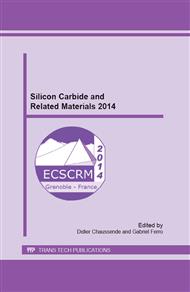p.822
p.826
p.830
p.834
p.838
p.842
p.847
p.851
p.855
4.5-kV 20-mΩ.cm2 Implantation-Free 4H-SiC BJT with Trench Structures on the Junction Termination Extension
Abstract:
A single-mask junction termination extension withtrench structures is formed to realize a 4.5 kV implantation-free 4H-SiCbipolar junction transistor (BJT). The trench structures are formed on the baselayer with dry etching using a single mask. The electric field distributionalong the structure is controlled by the number and dimensions of the trenches.The electric field is distributed by the trench structures and thus the electricfield crowding at the base and mesa edges is diminished. The design isoptimized in terms of the depth, width, spacing, and number of the trenches toachieve a breakdown voltage (VB) of 4.5 kV, which is 85% of thetheoretical value. Higher efficiency is obtainable with finer lithographicresolution leading to smaller pitch, and higher number and narrower trenches.The specific on-resistance (RON) of 20 mΩ.cm2 is measuredfor the small-area BJT with active area of 0.04 mm2. The BV-RONof the fabricated device is very close to the SiC limit and by far exceeds thebest SiC MOSFETs.
Info:
Periodical:
Pages:
838-841
Citation:
Online since:
June 2015
Keywords:
Price:
Сopyright:
© 2015 Trans Tech Publications Ltd. All Rights Reserved
Share:
Citation:


